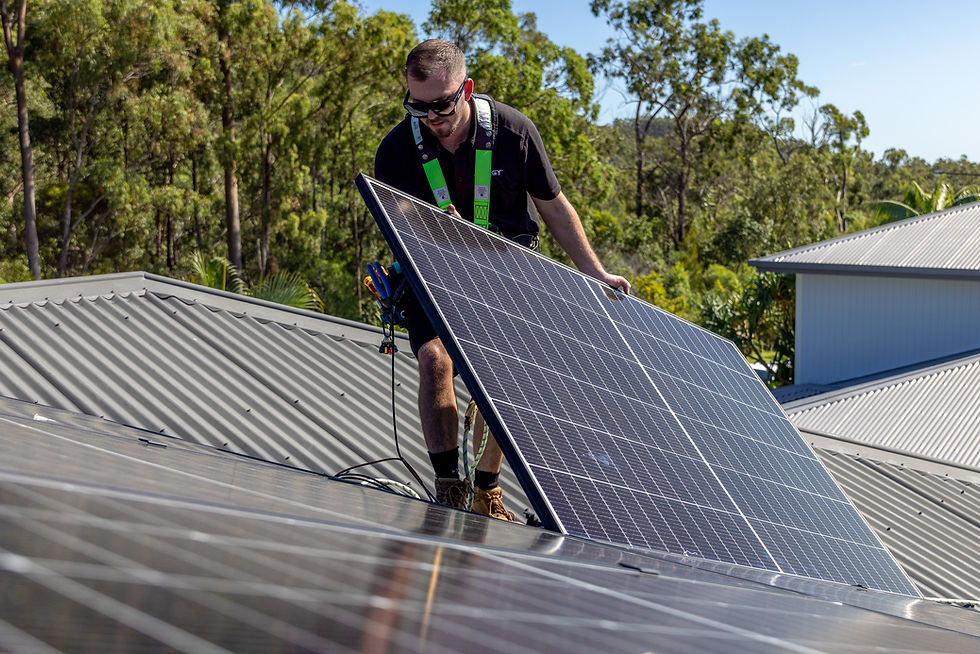How much solar do I really need? A clear guide for Australian homes
- Lochie Burgdorf
- Jul 27
- 3 min read
Updated: Jul 28

Whether you're building off-grid or just want to shrink your power bills, one of the first questions people ask is: how much solar do I actually need? The answer depends on a few key factors: your usage, your roof space, and your goals.
In this guide, we’ll break down how to figure out the right system size for your home or business, without the jargon. We’ll also look at how batteries and solar rebates affect what you really need.
1. Start with your power usage
Your electricity usage is the biggest clue. Check your power bill for your daily usage in kilowatt-hours (kWh). Most Australian homes use around 15 to 25 kWh per day, but this varies a lot depending on:
Family size
Air conditioning or pool pumps
Working from home
High-energy appliances like electric ovens, dryers, or EVs
TIP: Grab a full year's worth of bills to see how your usage changes between summer and winter.
2. Match your usage to system size
A rough guide to solar system sizes:
Daily Usage (kWh) | Suggested System Size (kW) |
5 to 10 kWh | 3 to 4 kW |
10 to 15 kWh | 5 to 6 kW |
15 to 25 kWh | 6.6 to 8 kW |
25 to 40+ kWh | 10 kW or more |
This table assumes good sunlight and northern-facing panels. Your installer will adjust based on your roof layout and shading.
3. Consider battery storage (or not)
Adding a battery like the Sigenergy SigenStor can store your excess solar energy to use at night or during blackouts. This changes your system needs.
If you want to run mostly on solar, even at night, you will likely need:
A larger solar system to generate extra during the day
Enough battery storage to power your home during non-sunlight hours
If you are grid-connected, you can export excess solar and draw power from the grid when needed.
4. What are your goals?
Your solar goals help determine your ideal system size:
Cutting bills: Match your system size to your usage
Going off-grid: Size for winter generation plus battery storage
Protecting from blackouts: Add battery backup or a hybrid inverter
Future-proofing: Plan ahead for EVs, new appliances, or pool equipment
A good installer will tailor your system not just for today, but for the future too.
5. How much roof space do you have?
Most solar panels are about 1.7 square metres each and generate around 370 to 440 watts. A 6.6 kW system typically needs:
16 to 18 panels
Around 30 to 35 square metres of usable roof space
If roof space is limited, higher-efficiency panels can help get more output with fewer panels.
6. What about solar rebates and incentives?
Australia offers generous rebates that significantly reduce solar system costs. These are calculated based on system size, so larger systems often give more value per dollar.
To check what you’re eligible for:
Visit the Clean Energy Regulator
Explore your state government’s solar incentives
Or speak with your installer. Most apply the rebate directly into your quote
7. Still unsure? Ask for a personalised quote
The best way to get the right system size is with a custom solar quote. A trusted installer will assess:
Your energy usage patterns
Roof space and panel placement
Battery options if needed
Your long-term energy goals
They can also model how much you’ll save on power over time.
Final thoughts
Getting solar is a smart move, but choosing the right size is key. Start with your usage, think about your goals, and get professional advice.
Too small and you might miss out on savings. Too large and you could overspend. The sweet spot is where the system works for your lifestyle and gives you maximum return on investment.
Not sure what size solar system you need? At Nergy, we make it simple. Our local team will look at your power usage, your roof space, and your goals to recommend the right setup, no fluff, just honest advice.
Get your free solar quote today and take control of your power.


Comments